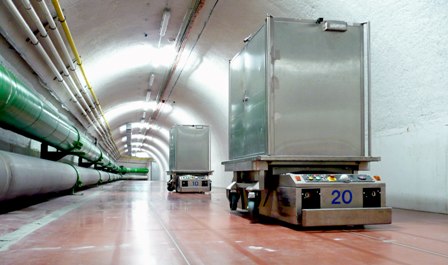
Automated guided vehicles (AGVs) are becoming increasingly popular for efficient transportation of goods within hospitals. Such driverless vehicles typically move linen, refuse, medical waste, patient meals, soiled food trays and even surgical instruments. They can be programmed to open doors and use lifts automatically, allowing access to practically any area in a building.
Motol University Hospital in Prague is a good example of a medical centre that over the past 16 years has taken full advantage of AGV technology, in this case supplied by E&K Automation. The hospital, which employs 5,000 staff, is the biggest in the Czech Republic, with 2,400 beds for patients of all ages.
The flexible AGV system is an integral part of the hospital's future, owing to the longevity of the constituent parts and E&K's ability to constantly upgrade and develop the installation to suit the customer's ever-changing needs.
Today, the institution's infrastructure includes a 38-vehicle AGV system for transport of goods within and between the different buildings, including the original children's hospital complex and an adult hospital built some years later.
Back in 1972, when the children's hospital was opened, movement of goods within the buildings was carried out using manual carts and a limited number of lifts. Transport between buildings involved the use of trucks.
It was decided in 1983 to erect a new centre for adults near the existing children's hospital. The project included the construction of a new, large-scale kitchen and a central store that includes an archive for medical files. At the planning stage, provision was made for the later introduction of an AGV system to service the buildings. However, it was not until 1995 that the E&K automated transport system entered service.
The adult hospital was constructed with an underground corridor leading to the children's hospital so that it too would benefit from automated goods handling. From the end of the corridor, the idea was for containers to be handled manually into lifts and to their destinations by hospital staff in the children's section.
The inductive control wires that the AGVs follow in both directions were installed along the corridor, on each floor of the adult hospital buildings and in the lifts. Communication between the vehicles and the E&K control system employed induction loops in the floors at predefined distances. These guidance and communications technologies were of course standard in AGV systems of the early 1990s. In all, 28 vehicles were deployed.
Modernisation of the AGV network
In 2006, a complex modernisation of the children's hospital was instigated, which was only completed in April 2011. It included a €2.8 m project for E&K to supply 10 new AGVs and extend the AGV system from the end of the corridor to all of the children's wards. Reconstruction also involved installation of four new battery charging stations and 10 new lifts for the AGVs to access wings A, B and C of the children's hospital. Civil work included further underground corridors for the AGVs to access the new lifts and construction of another operating theatre.
It was impractical to extend the AGV transport network and retain the old communication system. Moreover, spares for the early vehicles and control computers were becoming difficult to source. In addition, after eleven years of daily use, the vehicles needed refurbishing. So the complete AGV control and communication system was modernised as part of this project; refit being a core E&K business unit for the upgrade and refurbishment of both E&K and competitors' AGV systems.
New control and communication systems
Between 900 and 1,000 containers are now transported every day around the AGV network at Motol University Hospital, all year round. During reconstruction and extension, it was essential that automated movement of goods was not affected.
A WLAN-based control and communication system was supplied along with the new AGVs. The former was installed over the entire area within and between the hospitals, independently of the old system and alongside it. This part of the project also included access points for the lifts. Operation of the old system, including communication with the vehicles, could therefore continue normally. Switching between the old and new control systems was done by means of a simple changeover switch.
Each night, when batteries powering the 1995 vehicles were being recharged, the new vehicles, control system, lift control and WLAN were tested. That was the most difficult time during the modernisation of the system, because at 5.30 the next morning, the entire system had to operate at full capacity again.
That phase took several months, after which the conversion and overhaul of the old AGVs, including installation of new communication modules, was completed within six weeks. The critical moment occurred when the 10 new vehicles were brought online with the 28 old AGVs, as the decision to switch to the new system permanently was then irrevocable.
During hospital operation, there are no fixed rules concerning the number and frequency of transports. Each day is different and control at peak times is performed in software by setting priorities according to the urgency with which goods are needed. The longest transport distances are in excess of half a kilometre and vertically the vehicles travel in lifts up to 12 storeys.